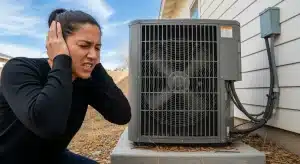
Las Vegas summers push past 110 °F, and a noisy air conditioner only adds stress. While some hums and whooshes are normal, loud rattles, squeals, or hisses signal trouble. In this comprehensive guide, you’ll learn why air conditioner making noise isn’t just annoying—it can shorten system life—how to troubleshoot every common sound from buzzing to grinding, clear DIY steps to quiet your unit, when to call a pro, and strategies to prevent noise before it starts. We’ll also dive deep into long-tail issues like AC unit making banging noise, air conditioner making clicking noise, and AC fan not working, ensuring you have every tool to restore peace and comfort.
Why AC Units Make Noise
Air conditioners are mechanical systems with compressors, fans, motors, relays, and refrigerant lines—all designed to move heat from indoors to outdoors. When everything works smoothly, you’ll hear a gentle humming or soft whoosh of air movement. But when components wear, misalign, or become obstructed, noises intensify or change pitch. Here’s a breakdown:
- Compressor humming/knocking: The heart of your outdoor unit. A healthy compressor hums steadily; worn bearings or failing valves produce knocking or grinding.
- Fan blades whooshing or rattling: Outdoor and indoor fans circulate air. Debris or bent blades cause vibration, leading to rattling sounds.
- Electrical relay clicking/buzzing: Relays engage the compressor and fan motors. Worn contacts click loudly or buzz under load.
- Refrigerant hissing/bubbling: High-pressure refrigerant rushing through lines. A leak amplifies hissing near coils or connections.
- Ductwork pinging/creaking: Metal ducts expand and contract with temperature changes. Airflow pressure can cause ducts to flex and flap.
Understanding these baseline noises helps you identify what’s normal and what demands attention, whether it’s AC not cooling fan not running or a persistent squeal that won’t fade.
Common Causes of Noisy AC Units
1. Loose Panels or Fasteners
Buzzing or rattling like a loose hinge. Every time the compressor cycles or fan spins, vibrations can loosen screws, panels, and brackets, causing metal to vibrate against the frame.
- DIY Solution: Turn off power at the breaker, remove any access panels, and use a torque screwdriver to snug all fasteners, including fan guard screws and control box cover bolts.
- Tip: Inspect the service panel on your air handler too—internal panels can come loose and rattle against the blower housing.
2. Debris in the Outdoor Unit
Scraping or thumping sounds as blades hit foreign objects. AC units sit outdoors, attracting leaves, twigs, dirt, even small animals. Twigs can wedge between blades and coil fins, causing intermittent scraping.
- DIY Solution: Shut off the disconnect switch, remove the top cover, and gently clear debris by hand or with a soft brush. Avoid high-pressure washers that can damage fins.
- Preventive Tip: Trim landscaping to maintain a 3-foot clear zone around the unit and install a mesh cover over the fan inlet.
3. Worn Fan Blades or Motor Bearings
Squealing, grinding, or humming under load. Fan motors use bearings or bushings that need lubrication. Without it, friction rises, causing high-pitched squeals or grinding.
- DIY Solution: For sleeve-bearing motors, apply a few drops of non-detergent oil at the oil ports. For ball-bearing motors, check manufacturer guidance—some are sealed and must be replaced if worn.
- Expert Tip: Measure motor RPM with a laser tachometer: readings 10–20% below nameplate indicate bearing or winding issues.
See also: detailed fan guidance in AC Blower Motor Basics.
4. Refrigerant Leaks
Continuous hissing or bubbling near line sets or coils. A small leak can turn into a noisy, inefficient system. Leaks not only make noise but also lower cooling capacity.
- Warning: Refrigerant is hazardous and regulated. Do not attempt DIY repairs.
- Professional Action: Contact an EPA-certified tech to perform leak detection with electronic sniffers or UV dye. After repair, the system must be evacuated and recharged precisely to prevent noise and performance loss.
5. Failing Electrical Components
Buzzing contactors, rapid relay clicking, or crackling sounds. Electrical relays control the compressor and fan motors. Worn contacts arc and buzz, creating a distinctive humming or crackling sound.
- DIY Awareness: You can visually inspect the contactor for pitted or burnt contacts, but replacement requires electrical know-how and safety precautions.
- Professional Replacement: Have a licensed technician swap in new contactors and relays rated for your system’s voltage and amperage. They’ll also check control board voltages to ensure no hidden faults.
See also: avoid shady services in Identifying & Avoiding AC Repair Scams.
6. Clogged Air Filter
Whistling or groaning as the blower struggles. An overloaded filter restricts airflow, forcing the blower motor to work harder and produce noise. Reduced airflow also leads to coil freeze-ups and inefficient cooling.
- DIY Solution: Check your filter monthly. Replace 1-inch fiberglass filters every 30 days; pleated MERV 8–11 filters every 60–90 days depending on dust loads.
- Tip: When you change the filter, listen for immediate noise reduction—this confirms airflow restriction was the culprit.
7. Loose or Unsealed Ductwork
Pinging, rattling, or flapping noise when the system runs. Air pressure inside ducts can flex metal panels at seams or corners. Even minor separations let air escape, creating vibration noise.
- DIY Fix: Locate accessible duct joints in the attic or crawlspace. Use UL-rated foil HVAC tape or mastic sealant to secure connections.
- Professional Option: A duct-blaster test identifies hidden leaks and measures total leakage for optimal sealing.
8. Belt Issues in Older or Window Units
Squeals under load or chirps on startup. Some older split systems and window ACs use V-belts to drive fans. Over time, belts harden, crack, and lose tension.
- DIY Check: With power off, inspect belt condition. If cracks or fraying appear, replace with the exact OEM belt and follow the manual’s tension specifications.
- Preventive Tip: Include belt inspection in your spring maintenance routine—this can save blower motor damage from stalled belts.
Step-by-Step DIY Noise Reduction
Combine these actions for maximum quiet:
- Cut Power: Always switch off the breaker before working on HVAC equipment.
- Tighten Fasteners: Secure all screws, bolts, and panels on the indoor and outdoor units.
- Clear Debris: Remove leaves, dirt, and nests from the condenser and blower areas.
- Inspect & Straighten Blades: Realign any bent fan blades; lubricate motor shafts.
- Replace/Clean Filter: Ensure unrestricted airflow to the evaporator coil and blower.
- Seal Duct Joints: Apply foil tape or mastic to visible seams.
- Check Belts & Pulleys: Replace worn belts and adjust tension per spec.
After each step, power on briefly to confirm noise reduction before proceeding. If noise persists, escalate to professional help.
When to Call a Professional
Early DIY fixes handle 80% of noise issues, but these scenarios require expert intervention:
- Loud hissing: Suspected refrigerant leaks endanger performance and health.
- Sparking or crackling: Electrical arcing poses fire and shock hazards.
- Persistent heavy clanking: Internal compressor or bearing failure.
- Continuous rapid clicking: Control board or relay malfunctions.
- Severe squealing: Locked or seizing motors under load.
Don’t risk DIY on these issues. Book our licensed AC Repair Services in Las Vegas for safe, reliable resolutions available 24/7.
Preventing Noise Before It Happens
A proactive maintenance plan keeps your system whisper-quiet:
- Change filters every 1–3 months to prevent blower strain.
- Keep outdoor unit clear of plants and debris within a 3-foot radius.
- Schedule professional tune-ups each spring and fall to inspect and lubricate bearings, test capacitors, and tighten electrical connections.
- Have an EPA-certified technician perform refrigerant pressure and leak tests annually (EPA Section 608).
- Seal and insulate ducts to reduce motor runtime and noise.
For landlords and tenants: follow our AC Repair for Rental Properties checklist to maintain quiet, efficient units in every home.
Advanced Considerations & Upgrades
If your system still sounds loud after maintenance, consider technology upgrades:
- ECM Fan Motors: Electronically commutated motors run up to 50% quieter and use less electricity.
- Acoustic Enclosures: Retrofit your condenser with sound-dampening panels or pads designed for outdoor units.
- High-SEER Units: Newer models operate at lower RPMs and include factory sound insulation.
Health & Safety Resources
Maintain safe practices and indoor air quality:
- OSHA HVAC Safety Hazards guidelines for technicians.
- NIOSH Indoor Environmental Quality Guidelines for healthy indoor spaces.
Conclusion & Call to Action
A noisy air conditioner is more than an annoyance—it’s a sign your system needs attention. By diagnosing sounds from buzzing to grinding, performing simple DIY fixes, and scheduling regular tune-ups, you’ll extend equipment life, save on energy costs, and ensure peaceful, reliable cooling. Ready for expert help? Schedule 24/7 AC Repair in Las Vegas today!



